“Easy choices, hard life. Hard choices, easy life.”
In life, decision-making is hard because most of us don’t know how to choose. How do you make it easy?
If you can’t decide and there are a lot of factors that go into every decision, then you can use simple math to help you out.
I will show you a mathematical approach to making hard decisions and showcase how to use the weighted decision matrix and fear setting to help you make the better choice.
Table of contents:
how to make a hard decision between two things
To make better decisions you can use the weighted decision matrix. It helps you calculate a score for each decision so that it’s easier to see which one you prefer.
Black or cappuccino? Ask her out or not? Bachelor’s degree or online business? Mac or Windows? Pineapple on pizza or no pineapple? New iPhone or holiday?
Some of these are hard to make but what if you could use simple math to help you decide what you want?
Some decisions are easy, I like black coffee instead of cappuccino and that’s that. But there are those annoying ones that have so many factors that go into them. For example which degree to pursue? To drop out or not?
Each option has many pros and cons and then there are your emotions and other people telling you things but you don’t want to disappoint them.
That’s where the weighted decision matrix comes in.
You can do this on a piece of paper or Google Sheets to make it easier.
1. Identify and write down the decisions and their factors
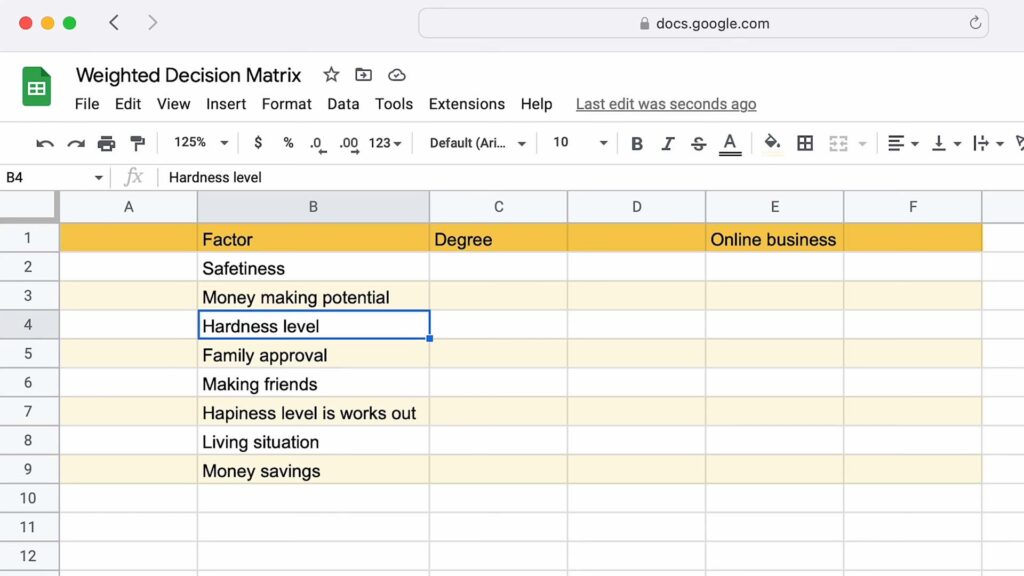
Skip one column, enter the factor, enter the name of the first decision, skip one more column, and enter the name of the second decision. You can do this with however many things you’re choosing from.
In the factors column write down all the things that are influencing your decision, this list can be very long, think of even the most insignificant factors.
2. Eliminate Emotions
Humans are bad at making decisions.
Why? Because of our emotions. We are emotional creatures and more often than not we use our emotions but not our rational brains to try to make hard decisions.
Many cognitive biases trick our brains into thinking that we’re making the right decision.
Sunk cost fallacy is our tendency to continue with an endeavor we’ve invested effort, money, or time into—even if the current costs outweigh the benefits.
For example, continuing to be in an abusive relationship because you’ve already sunk so much time and effort into building it. Or pursuing a certain career that you don’t enjoy because you’ve spent years training and learning for it. That’s the sunk cost fallacy. It’s hard but when we’re deciding we shouldn’t look at sunk costs.
Leaving our emotions aside is the key to making better decisions.
Thinking as objectively as possible will help you assess each factor in your decision-making process to help you pick the right choice for you.
3. Assign a 0 to 10 score to each factor
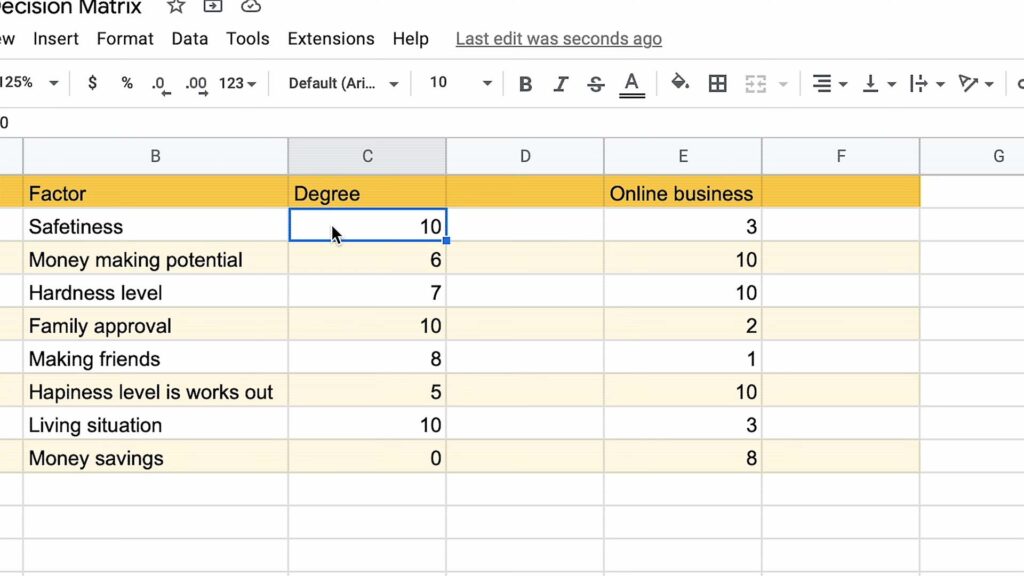
Next, leaving your emotional attachment aside, and thinking as logically as possible, assign a 0 to 10 score to each factor for every decision.
I put 10 in the safeness for the degree because it’s pretty safe going to college and 3 for online business because it’s pretty risky starting a business. Or making friends is 8 in college because it’s easier than making them sitting at home. You get the point.
Make sure that for all the factors 10 means the best and 0 means the worst. For example, if a factor is named cost, then 10 would mean there’s no cost at all, it’s the best cost, and 0 would mean that it’s very expensive.
4. Write how important each factor is
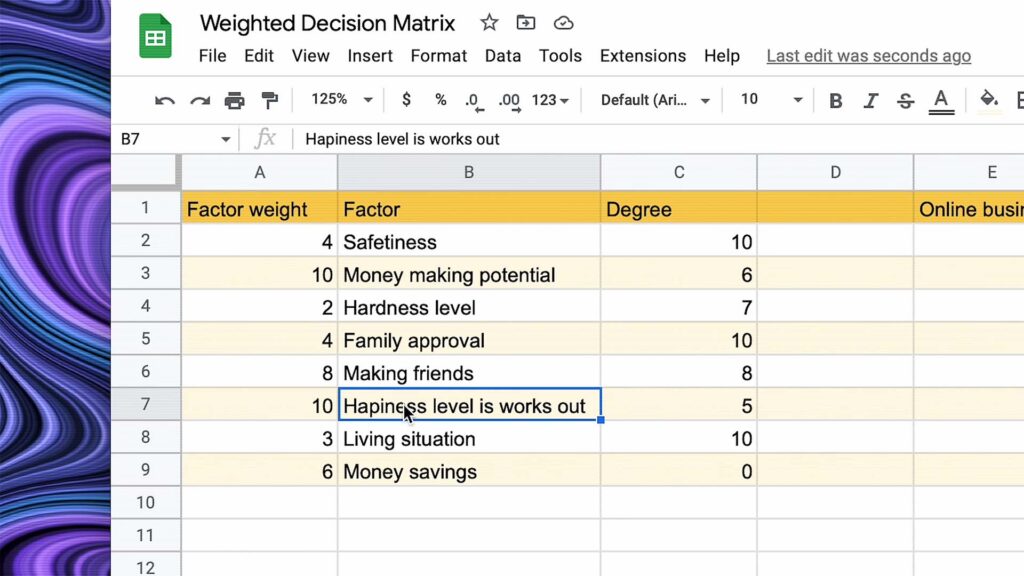
Name the first column factor weight. This is where you will enter how important this factor is for you from 0 to 10.
Again, here, think with as few emotions as possible. For example, I don’t care about my living situation so I put a 3. And I care a lot about my happiness so I put 10.
5. Calculate weighed score for each factor
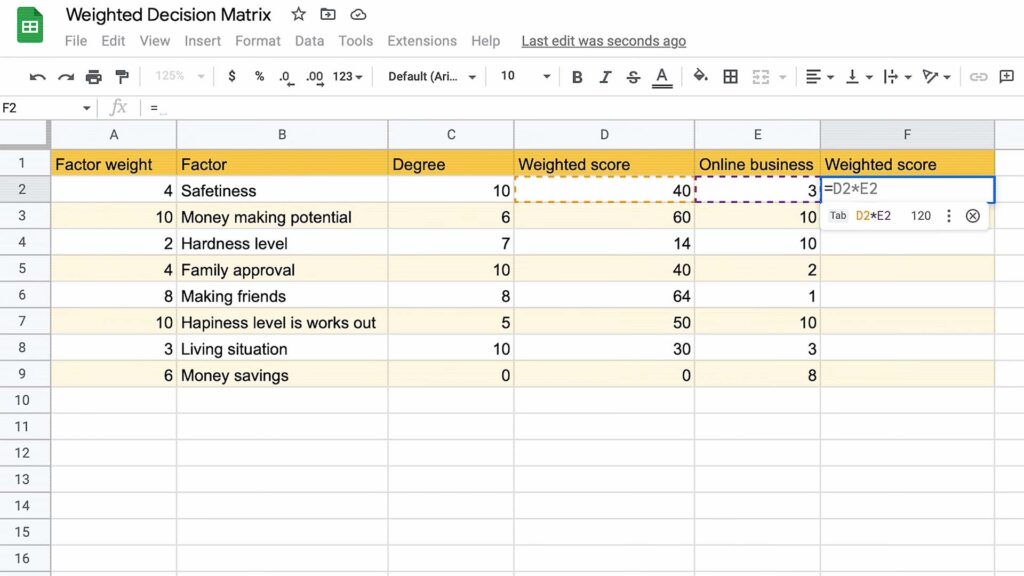
Name a column after each decision “weighted score”.
Type equals click on factor weight, times, and then your score for the decision. Then drag the formula down to apply it to every row.
Then for the next decision, equals, then factor weight times the other decision’s score.
6. Sum up the weighted score columns
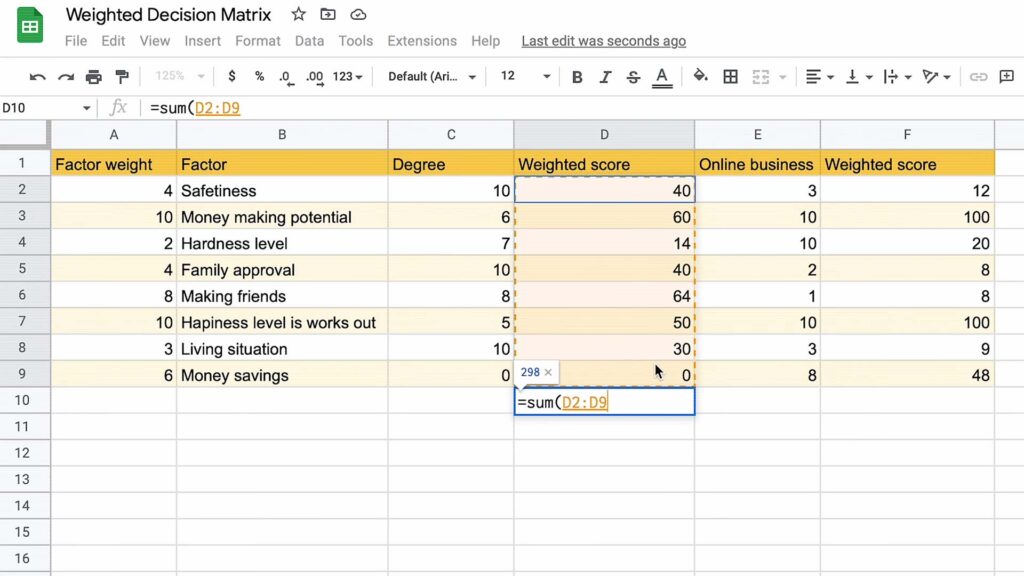
Come down to the bottom of the weighted score column type =SUM() select the numbers in that column and press enter. Do the same for the other weighted score.
This will add up the weighted score columns so you can see which total is larger.
7. Make the decision
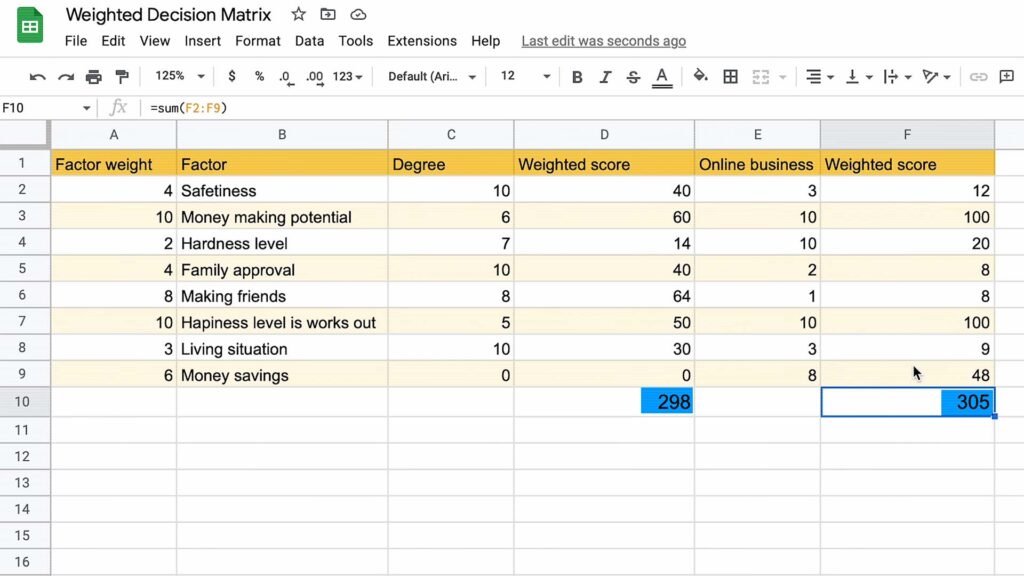
Whichever weighted score is higher, that’s your decision. For me, it’s starting an online business instead of going to college.
Of course, if you don’t like the decision that the decision matrix spits out as better for you, then you probably already made up your mind in the first place. It just helped you realize it.
Instead of doing all the work yourself, you can also download the Weighted Decision Matrix Google Sheets template here (enter $0 in the price field to download it for free).
Weighted decision matrix template
How to do the Fear setting exercise to make better decisions
Fear Setting is an exercise that helps you make decisions when fear is holding you back. It helps eliminate the emotional distortion that fear causes in your thinking.
Here’s how to do fear setting.
1. Define fears for the decision
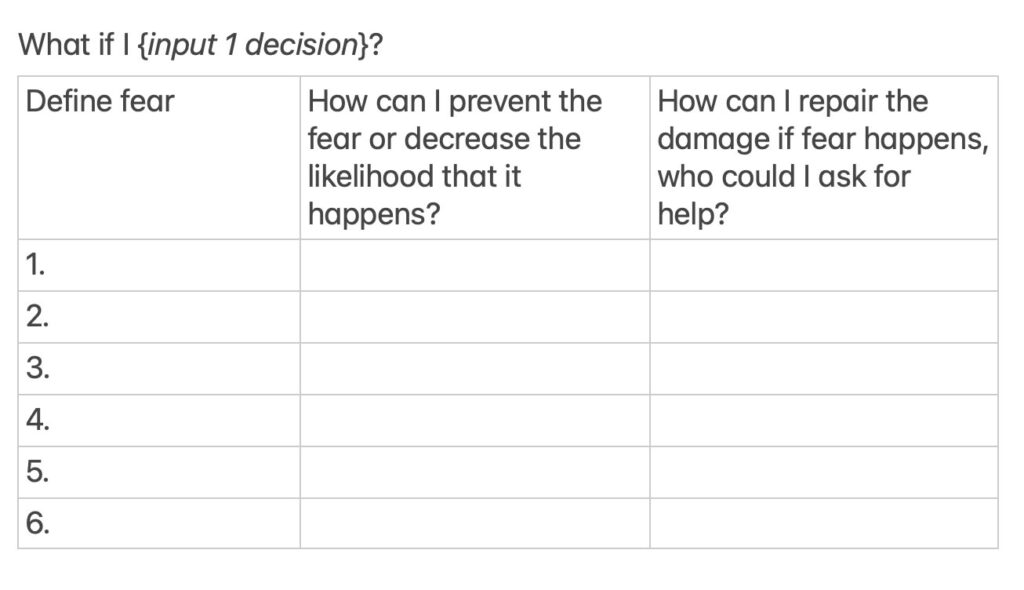
Create a table with three columns.
In the first column name the fears that you have about making the decision.
In the second column, for each fear write down how could you prevent the fear from happening or at least decrease the likelihood that it happens.
In the third column write down how could you repair the damage if the fear that you have happens. Think about who you could ask for help.
2. Define the benefits of The decision

Once you’ve defined your fears you can move on to writing down all the benefits of making your decision.
For example, if my decision was to quit pursuing my degree and start an online business the benefits would look something like this:
- Potential to earn a lot of money
- I will not have to work for someone else
- Ability to retire early
- I will not be tied to a schedule
- I get to help other people
- I can work from anywhere in the world
- I can take a holiday whenever I want to
- I can not work if I don’t want to
- I can outsource things that I don’t want to do myself
3. Define the cost of inaction
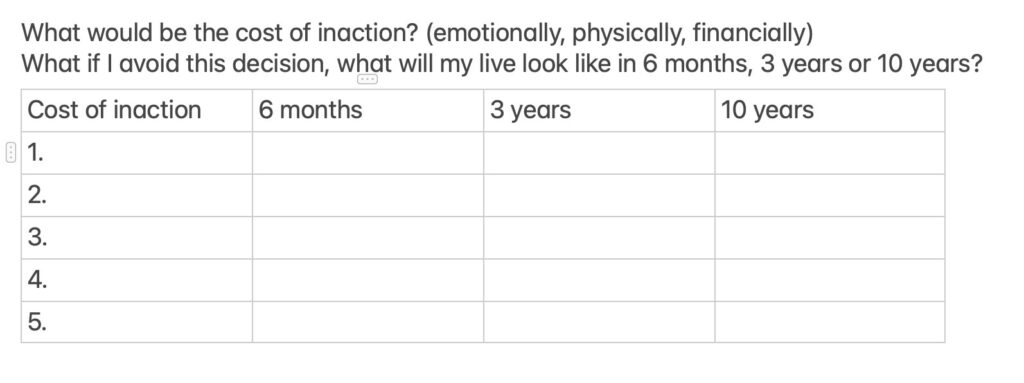
Once you’ve listed all the benefits of your decision, create a cost of inaction table.
Ask yourself what would be the cost of inaction (basically the cost of not making the decision now).
Ask yourself what if I avoid this decision? What will my life look like in 6 months, 3 years, or 10 years?
For example, if my decision was to start a YouTube channel the cost of inaction column would look something like this:
- My income/savings
- My YouTube channel subscribers
- My happiness
- My skills to make a great video
- My camera confidence skill
- My ability to quit my job and do YouTube full time
- My ability to communicate well, etc.
4. Define the risk of the decision
On a scale of 1 to 10, 1 being minimal impact and 10 being the most impact, how much would this decision impact your life?
Example: “If I make this decision I’m risking temporary and easily reversible 2 points of pain, for a benefit of 9 points of long-term, life-changing success.”
5. Make a decision
Most often than not, you’ll find that the fears you had are not so big and will not change your life drastically even if they were to happen. That’s why fear setting is such a great exercise to help you think clearly about making an important decision.
Now it comes time to make the decision. You know the fears, what to do if they come true, the cost of inaction, and the benefits of making the decision.
All that’s left is either committing to your decision or choosing the other option.
Was this guide for better decision making useful?
All in all, decision-making is a hard process for humans because our emotions often exaggerate our fears and cloud our judgment. Also, if there are many factors that go into every decision it can be difficult to determine which of them have the most importance. We can make this process easier by using 2 exercises – the weighted decision matrix and fear setting.
If you found this guide useful, I’m sure that you’ll also enjoy my newsletter. I send it out once a month with, a financial tip, some cool websites I discovered, or inspiring quotes from a book I’m reading. You can read it completely for free or subscribe to it by entering your email and you’ll get it for free every month inside your inbox.
Thanks for reading 👋.